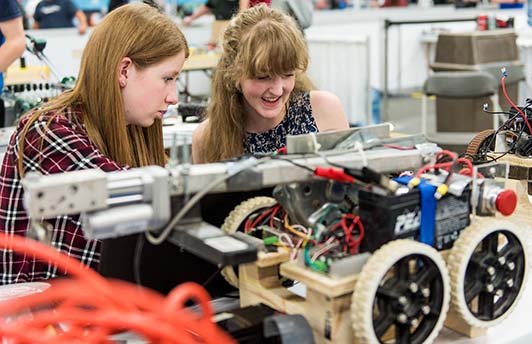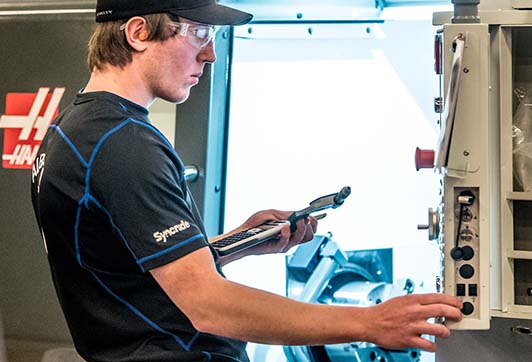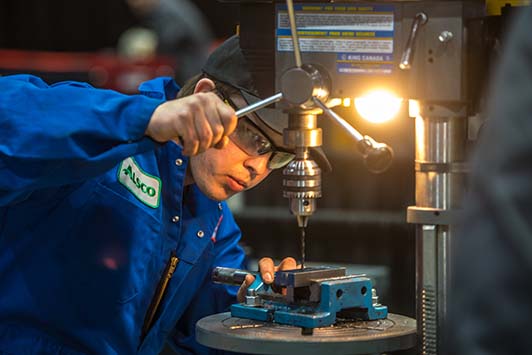Mechanical Engineering CAD
What is Mechanical Engineering CADD?
Computer aided design and drafting, or CADD as it is commonly known, is used by computer age mechanical draftspersons to translate product design concepts into accurate and detailed technical drawings and specifications for engineering, manufacturing or other purposes. These drawings describe the size, shape and function of objects and mechanical components for the use of design and production firms. A CAD draftsperson generally works closely with the production team, explaining or adjusting the drawings as work progresses. They must ensure that their drawings conform to the project’s requirements, while considering the limitations of the materials being used.
CAD drafting techniques have changed the work of the mechanical draftsperson, because the computer is faster, more accurate, allows design variations to be easily accomplished and has eliminated many of the repetitive tasks formerly associated with this profession. However, even though its use is rapidly replacing traditional manual drafting methods, much of the same knowledge of technical and engineering materials, practices and conventions is still required by this occupation
Drafting technologists perform some or all of the following duties:
- Develop and prepare engineering designs and drawings from preliminary concepts, sketches, engineering calculations, specification sheets and other data
- Operate computer-assisted design and drafting (CADD) workstations
- Develop and prepare design sketches
- Complete documentation packages and produce drawing sets
- Check and verify design drawings to conform to specifications and design data
- Write technical reports
- Prepare contracts and tender documents
- Prepare construction specifications, costs and material estimates
- Supervise and train other technologists, technicians and drafters.
HOW TO JOIN THE FIELD
Completion of secondary school is usually required.
Completion of a two- to three-year college program in engineering design and drafting technology or in a related field is usually required for drafting and design technologists.
Completion of a one- to two-year college program in drafting or Completion of a three- to four-year apprenticeship program or Four to five years of related experience plus completion of college or industry courses in drafting are usually required for drafting technicians.
Trade certification for draftspersons is available, but voluntary in Ontario.
Certification in engineering design and drafting technology or in a related field through provincial associations of engineering/applied science technologists and technicians may be required by employers.
A period of supervised work experience, usually two years, is required before certification.
INDIGENOUS AND REMOTE CONSIDERATIONS
Indigenous and remote communities are catching up to southern Canada when it comes to digital technology and computer skills and industries. Not all communities have access to reliable, affordable internet and service interruptions are all too common. Access to computers at home is not a given for everyone and Elders and even sometimes younger generations lack computer knowledge, although this situation is undergoing some significant changes at the moment. But even those people in Indigenous and remote communities with interest and high-level skills in computers may not have the same access to opportunities to learn about different programs and may face significant bandwidth issues, limiting their ability to learn and develop in this field. Indigenous and remote students may need qualifying courses or need to augment college learning to be successful in this field.
Although with significant improvements currently underway to internet connections in Indigenous and remote communities, careers in this field become more viable and are likely to become more so in years to come.
DISABILITY CONSIDERATIONS
Since this job may require sitting at a computer for long periods of time, people with visual disabilities may find it challenging. They may require specialized screens. Also, as it may require sitting for long periods of time, people with certain physical disabilities may struggle as well. Accommodations such as standing desks may make the work more comfortable and ergonomic. However, the fact that this work is digital in nature, may make it attractive to people with mobility disabilities, as they may be able to perform most of the work duties from the comfort of their home. People with learning disabilities may require extra support in post-secondary as well as on the job to ensure their success.
Find the right career path for you with our interactive map!
Trouvez le cheminement de carrière qui vous convient grâce à notre carte interactive!
Sample Job Titles
- Industrial designer
- Technical illustrator
- Architectural draftsperson
- CADD Technician
- Electrical draftsperson
Companies and Sectors
- Manufacturing companies
- Engineering companies
- Industrial design firms
- Self-employed

Mechanical Engineering CAD and the Skills for Success Program
The key Skills for Success for this career path are:
- Numeracy
- Problem Solving
- Reading



